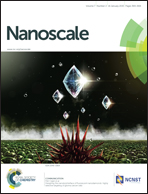Evolution of Ni nanofilaments and electromagnetic coupling in the resistive switching of NiO†
Abstract
Resistive switching effect in conductor/insulator/conductor thin-film stacks is promising for resistance random access memory with high-density, fast speed, low power dissipation and high endurance, as well as novel computer logic architectures. NiO is a model system for the resistive switching effect and the formation/rupture of Ni nanofilaments is considered to be essential. However, it is not clear how the nanofilaments evolve in the switching process. Moreover, since Ni nanofilaments should be ferromagnetic, it provides an opportunity to explore the electromagnetic coupling in this system. Here, we report a direct observation of Ni nanofilaments and their specific evolution process for the first time by a combination of various measurements and theoretical calculations. We found that multi-nanofilaments are involved in the low resistance state and the nanofilaments become thin and rupture separately in the RESET process with subsequent increase of the rupture gaps. Theoretical calculations reveal the role of oxygen vacancy amount in the evolution of Ni nanofilaments. We also demonstrate electromagnetic coupling in this system, which opens a new avenue for multifunctional devices.


 Please wait while we load your content...
Please wait while we load your content...